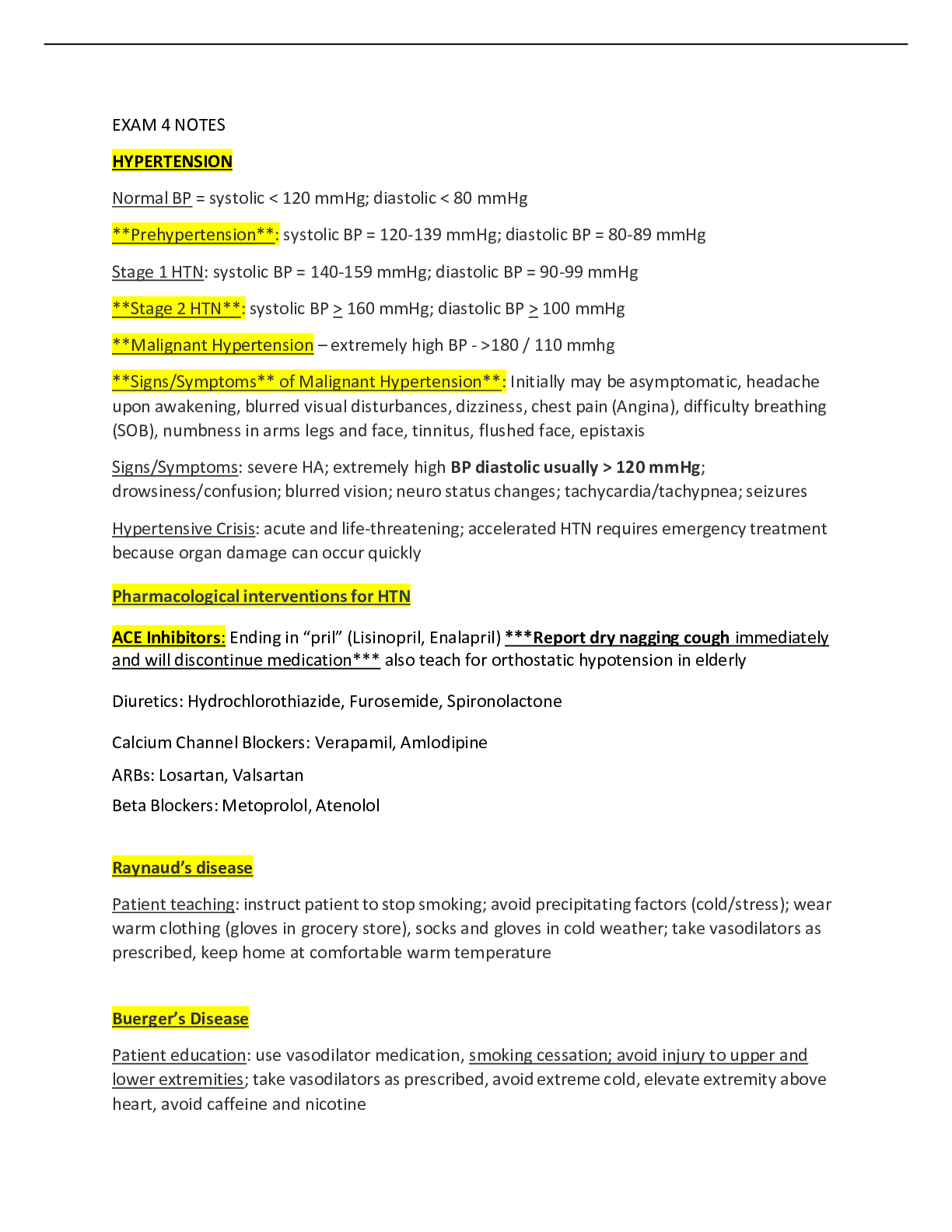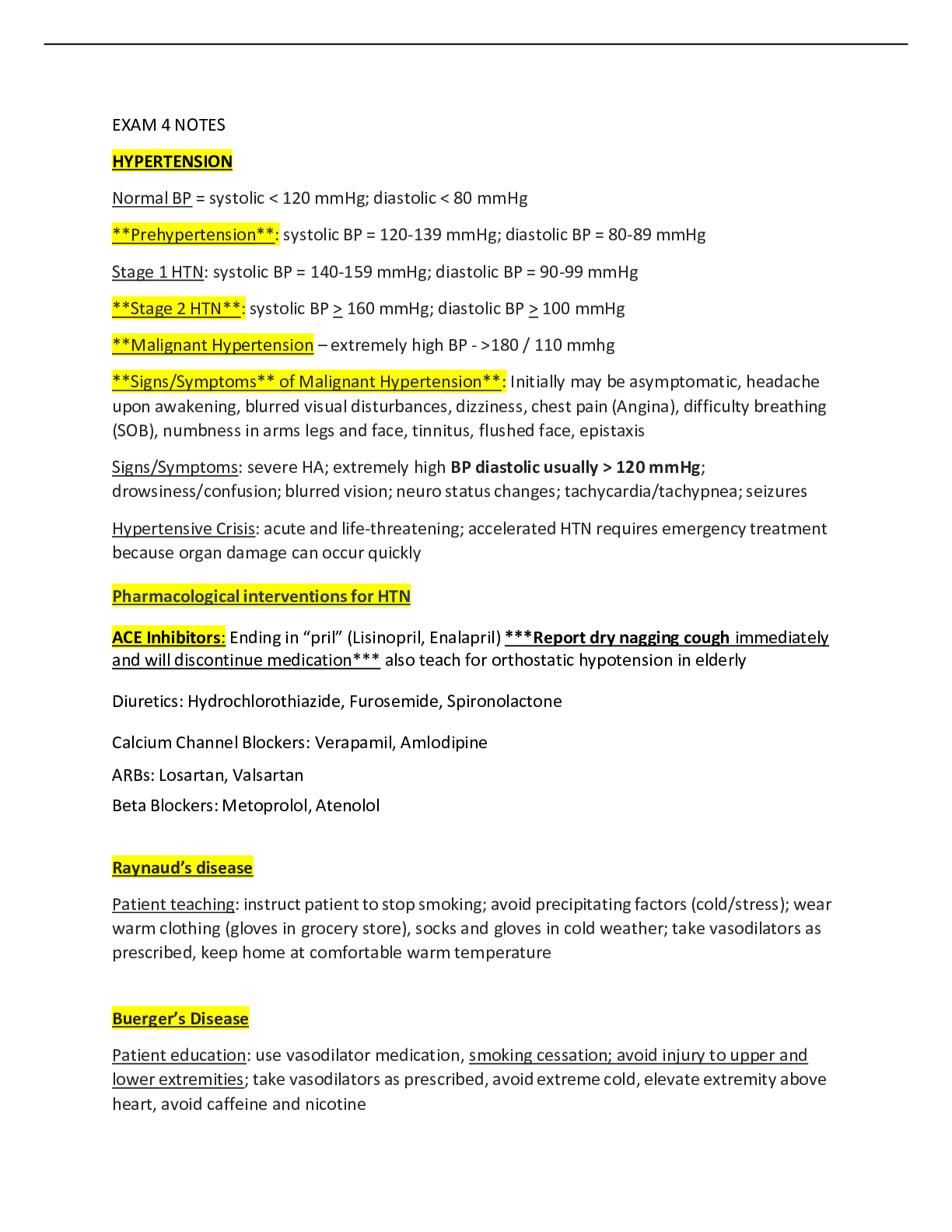HYPERTENSION
Normal BP = systolic < 120 mmHg; diastolic < 80 mmHg
**Prehypertension**: systolic BP = 120-139 mmHg; diastolic BP = 80-89 mmHg Stage 1 HTN: systolic BP = 140-159 mmHg; diastolic BP = 90-99 mmHg
**Stage 2 HTN**: systolic BP > 160 mmHg; diastolic BP > 100 mmHg
**Malignant Hypertension – extremely high BP - >180 / 110 mmhg
**Signs/Symptoms** of Malignant Hypertension**: Initially may be asymptomatic, headache upon awakening, blurred visual disturbances, dizziness, chest pain (Angina), difficulty breathing (SOB), numbness in arms legs and face, tinnitus, flushed face, epistaxis
Signs/Symptoms: severe HA; extremely high BP diastolic usually > 120 mmHg; drowsiness/confusion; blurred vision; neuro status changes; tachycardia/tachypnea; seizures
Hypertensive Crisis: acute and life-threatening; accelerated HTN requires emergency treatment because organ damage can occur quickly
Pharmacological interventions for HTN
ACE Inhibitors: Ending in “pril” (Lisinopril, Enalapril) ***Report dry nagging cough immediately and will discontinue medication*** also teach for orthostatic hypotension in elderly
Diuretics: Hydrochlorothiazide, Furosemide, Spironolactone Calcium Channel Blockers: Verapamil, Amlodipine
ARBs: Losartan, Valsartan
Beta Blockers: Metoprolol, Atenolol
Raynaud’s disease
Patient teaching: instruct patient to stop smoking; avoid precipitating factors (cold/stress); wear warm clothing (gloves in grocery store), socks and gloves in cold weather; take vasodilators as prescribed, keep home at comfortable warm temperature
Buerger’s Disease
Patient education: use vasodilator medication, smoking cessation; avoid injury to upper and lower extremities; take vasodilators as prescribed, avoid extreme cold, elevate extremity above heart, avoid caffeine and nicotine
Peripheral Arterial Disease (PAD) Intermittent claudication Sign & Symptoms – Leg Pain - burning, cramping muscle discomfort or pain when walking that stops at rest; as disease progresses, can walk shorter distances
Femoral artery bypass graf t surgery:
Post op care: warmth, redness, and edema of the affected extremity is expected; monitor for possible graft occlusion (Iggy, p. 791, critical rescue box) Monitor for continuous aching pain which may be 1st sign of occlusion. Throbbing pain is due to increased blood flow to the area. Check every 15 minutes for 1st hour, then hourly after that. Compare to other leg, if feels cold, pale, ashen, cyanotic, decreased or absent pulse, contact surgeon immediately.
Amputation Complications: infection; phantom limb pain; flexion contractures Post-OP – To prevent Hip flexion contractures, do not elevate limb on a pillow. 1st 24 hours - elevate foot of bed to decrease edema then keep bed flat
After 24-48 hours – place patient in prone position to stretch muscles and prevent hip flexion contractures
Deep Vein Thrombosis (DVT) = most common type of thrombophlebitis; high risk for PE
Commonly occurs in the legs but can also occur in the upper arms
Classic signs/symptoms = calf/groin tenderness or pain and sudden onset of unilateral swelling of the leg; positive Homan’s sign (not reliable due to false positive results)
Risk factors: venous stasis from varicose veins, heart failure, immobility; surgery; use of oral contraceptives; ulcerative colitis; prolonged bedrest, sitting too long (Airplane)
Interventions: (Iggy, p. 800) antiembolism stockings or sequential compression devices; elevate extremities; monitor for signs/symptoms of PE; IV continuous heparin – monitor aPTT values (call physician if > 70 seconds); therapeutic levels are usually 1-1/2 to 2 times normal control levels; oral anticoagulants follow IV heparin (INR 2-3).
LABS –
PT – 11-12.5 sec 1.5-2.5 times the normal control on Coumadin PTT – 60-70 sec 1.5-2.5 times the normal control on Heparin APTT – 30-40 sec 1.5-2.5 times the normal control on Heparin
Read More


